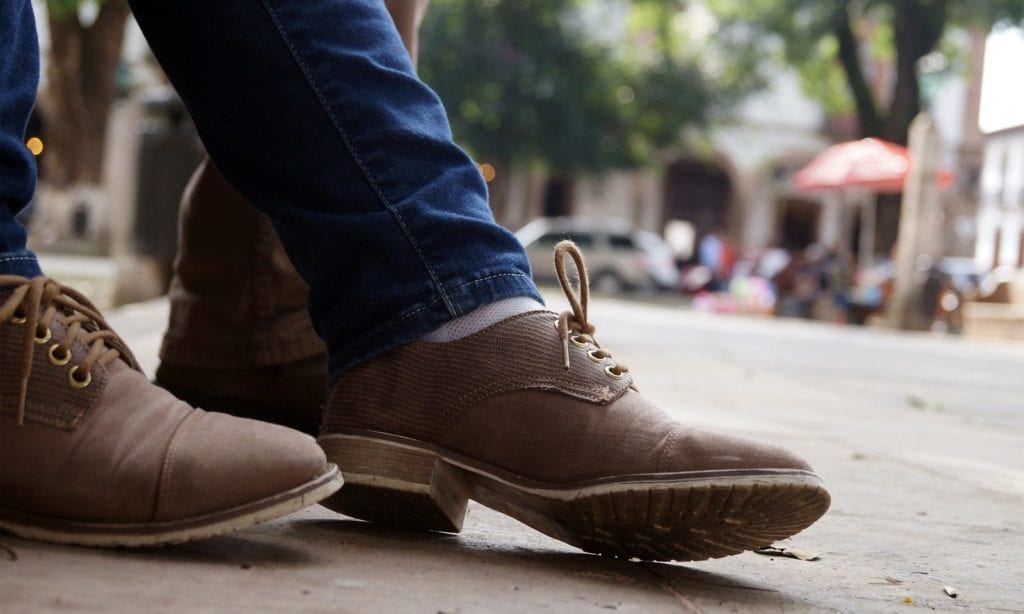What Causes calf’s to Tighten up When Walking on Concrete?

Introduction
Muscles, joints, and bones take a jarring when walking or standing for prolonged periods of time on hard surfaces such as concrete floors. This can lead to a condition known as Achilles Tendinitis where you find you develop extreme calf and heel pain. Of course, it can also lead to back, neck, leg and foot pain as well causing some types of arthritis, wearing the correct footwear when walking on concrete floors can alleviate some of the problems associated with this.
Is Walking on Concrete bad for your Joints?
Walking on concrete takes a toll on every part of your body including your joints, especially your ankles and knees. In fact, knee problems are a common problem for people who work in an environment where they have to stand or walk on hard concrete floors for extended periods of time. The impact of walking on these hard surfaces can lead to you hurting your knees and stress out your other joints.
Related: Running Shoes for Bad Knees.
This problem can lead to further complications such as developing a form of arthritis called osteoarthritis, which is a type of wear-and-tear arthritis that can be developed from walking or standing on hard surfaces on a daily basis for long periods. The joints in your knees, ankles and your foot itself can be adversely affected by walking on concrete floors and in order to ensure that you protect yourself from long-term injury.
As well as pain and fatigue, you need to wear the correct shoes to protect your feet and body. Wearing shoes that have a high level of shock absorbency is the first step to protecting your joints from the impact associated with walking on these hard surfaces for long periods. Cushioning in the right areas, spread across the sole of the shoe is also an important consideration.
When walking you spread the shock throughout your foot and the cushioning on the shoe should provide the required padding and cushion to alleviate this. You should also have a shoe that supports your ankles and feet at all times as well as one that allows your foot to breathe and remain cool and dry during the day.
Does Walking on Concrete take Calcium from your Body?
No walking on concrete does not take calcium away from your body, however, it can cause problems that will require you to supplement your calcium intake to rectify or help to cope with these conditions. One of the major problems experience by people, mostly women, when walking on concrete for long periods of time is that they may develop stress fractures. This is caused when the impact of walking shock your bone instead of your muscles.
 Women are more prone to this phenomenon than men because their bone density, as well as their muscles, are not able to cope with the shock it experiences when walking on hard surfaces for prolonged periods. In order to treat this condition, you will have to supplement your diet with foods that contain high levels of calcium.
Women are more prone to this phenomenon than men because their bone density, as well as their muscles, are not able to cope with the shock it experiences when walking on hard surfaces for prolonged periods. In order to treat this condition, you will have to supplement your diet with foods that contain high levels of calcium.
Another problem that can develop when walking on concrete is shin splints, again calcium intake is recommended when you develop these in order to help the bone heal. Shin splints cause you to develop muscle problems and inflammation in the muscles, causing stiffness in your feet. You will require anti-inflammation medication to treat the condition.
Wearing the right shoes will go a long way in preventing both stress fractures and shin splints. Having a shoe that can help your body absorb the impact as you walk will help it to protect your joints and muscles as well as your bones. Comfortable, well-padded and stable shoes are needed if you are going to be working in an environment where hard concrete floors are what you are standing or walking on all day long.
Is Walking on Concrete good for Arthritis?
No walking on concrete is definitely not good for arthritis. It will, in fact, make your arthritis worse. There are ways to overcome this though if you wear the correct footwear, you can prevent the worsening of your arthritis. Arthritis is a disease that is very common, and even so it is not very well understood. Arthritis is a disease of the joints and muscles, and if you have it you will experience pain when walking and especially when walking on hard surfaces where your joints and muscles are jarred with every step you take.
One of the most common forms of arthritis is the wear-and-tear or osteoarthritis. This can be directly related to spending too much time either walking or standing on concrete without wearing the correct footwear. Footwear that has shock absorbing qualities, that are spread throughout the shoe and not just concentrated on the toes and heels, along with superb padding and cushioning to alleviate the jarring of walking on hard surfaces, great stability with non-slip outsoles that are supportive.
Outsoles should be thick and pliable to allow you to feel as if you are walking on a cushioned surface and not concrete. The uppers of the shoe should offer you the support you need for ankles and should be breathable and durable. These are the types of shoes you should be considering in order to avoid developing the disease, or worsening it if you are already experiencing symptoms
Conclusion
Wearing the right shoes when you are going to be walking or standing on a hard concrete surface all day long is very important. If you do not select the most supportive and comfortable shoes you can afford, you may find yourself suffering from numerous different foot ailments, along with back pains (see these shoes to reduce back pain), shin splints, stress fractures and more. Buying a great shoe to walk on concrete with is worth every penny you will spend and will ensure your joints and muscles are protected at all times.